| Web
and Book design,
Copyright, Kellscraft Studio 1999-2017 (Return to Web Text-ures) |
 (HOME)
|
|
CHAPTER VII. ACHILL TO SLIGO IT has been suggested before now that the domain of Achill Island, off the coast of Mayo, that wonderland of natural unspoiled grandeur, be preserved as a sort of national park. Its primitive beauties are impressively great without rising to splendour or magnificence. Said Sir Harry Johnston, in writing to the London Times: “Is it impossible that individuals and the State together should intervene before it is too late and save Achill Island as a national park, as a paradise in which the last aspects of the indigenous British fauna may be exhibited? This might be done without disturbing the indigenous population, who could still carry on their fishing industry and the amount of agriculture necessary to their subsistence, without interfering unduly with the wild birds and beasts of the island. There would be, of course, an absolute interdict against ‘sportsmen’ and gunners; it would no longer be permissible to shoot the seals that haunt the caves and rocks around Achill, while the deer, wild goats, foxes, eagles, ravens, swans, gulls, choughs, and other wild birds and beasts would be similarly protected. People would then visit Achill Island at all seasons of the year (the climate is remarkably mild in winter) for the pleasure and interest afforded by the contemplation of its wild fauna. We should, in short, have an object-lesson of what Ireland and most other parts of the British Isles were like under prehistoric conditions.” From this it will be inferred that there is every encouragement for such a procedure, did the powers but take their rightful initiative.
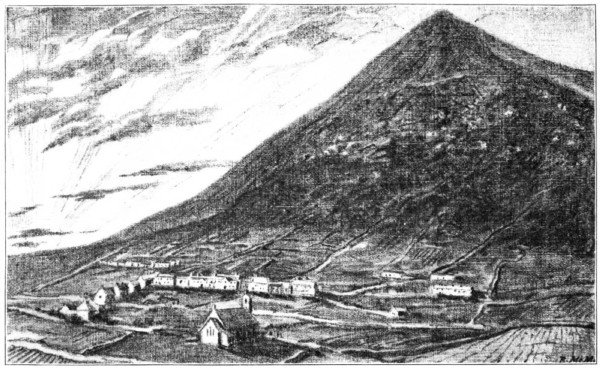 ACHILL ISLAND Whether such an event, if it come to pass, would make for a greater admiration of this lone and sea-girt bit of terra firma, it remains for others than the writer of this book to prognosticate. Certainly, under any aspect except that of the erection of multitudinous “resort hotels” and “furnished bungalows,” Achill Island is a wonderful resort for those in need of soothing influences; and, for its natural and unspoiled charms alone, should be kept quite as it now is. Achill is a veritable unknown wonderland. Not that it is actually unexplored, that it is vast, or that it is inaccessible. It is none of these; but few foreigners, or “aliens,” as the Irish prefer to think of strangers, have ever visited this little-known corner of Ireland, or even know where it is. Achill Island is the largest island on the Irish coast, in shape not unlike an irregular triangle, and contains an area of fifty-five square miles. To the north is the deeply indented Black Sod Bay, with its myriad smaller bays, while to the south is Clew Bay, populated with numerous tiny islets, and the high-held head of Croagh Patrick. Off to the northwest are the “Enchanted Isles,” the legendary homes of saints and recluses, among them Inishglora, Inishkeenah, and Inishkea. On one of these it is fondly believed by the natives that Ossian resided. Tradition has preserved the record thus: “Ossine MacFoin, seated on the banks of the Shannon, adoring the Author of Nature in the contemplation of his works, was suddenly hurried away to Tirna-n’oge (the country of youth, or island of immortals), which he describes with all the vivacity that fancy, aided by the sight of so lovely a country as Ireland, could assist the bard with. He remained here for some days he thought, and, on his return, was greatly surprised to find no vestige of his house or of his acquaintance. In vain did he seek after his father Fion, and his Fonne Eirion; in vain sounds the buabhal, or well-known military clarion, to collect those intrepid warriors. Long since had these heroes been cut off in battle; long had his father ceased to live! Instead of a gallant race of mortals which he had left behind, he found a puny and degenerate people, scarce speaking the same language. In a word, it appeared that, instead of two days, he had remained near two centuries in this mansion of the blessed.” (O’Halloran.) Achill itself contains scarcely a tree worthy the dignity of the name; but heath, gorse, juniper, and coarse grasses abound. Sleivemore has a height of 2,204 feet and Croghan 2,192. Both rise abruptly from the sea, after the manner of the castellated peaks in the fairy books, which, with their component castles, mostly do not exist out of books. Kildavnet Castle on Achill Sound was one of the numerous retreats of Grace O’Malley. Its square keep still stands. The arm of the sea on which it was built was so deep that vessels rode at low water under the very walls of the castle. “Here,” tradition states, “the skull of Grace O’Malley was formerly preserved, and valued as a precious relic. One night, however, — so the legend goes, — the bones of the famous sea-queen were stolen from their resting-place, and conveyed, with those of thousands of her descendants, into Scotland, to be ground into fertilizer. The theft was of course perpetrated in secret, and in the night-time. If the crew had been seized by the peasantry, with their singular cargo, not a man of them would have lived to tell the tale, for the Irish regard with peculiar horror any desecration of the graveyard.” According to a recent census, the population of Achill and Achill-beg, the baby islet off the southern limb of its parent, has decreased nearly ten per cent. in the space of ten years; from which fact it may be inferred that the popularity of this salubrious spot — for it ranks high among the world’s great natural sanatoria — is not increasing with the rapidity that might be expected. The two villages of the larger island, Keel and Dooagh, seem populous enough, as is also the Protestant community of Dugort. The island, in general, is exceedingly unproductive, though the sea yields a wonderful harvest to the fisher folk. There is but a narrow margin between the well-being and distress of the inhabitants, but signs are not wanting that whatever, in exceptional periods, may have been their condition, at present they are relatively better off than many of their compatriots in the west of Ireland. Considerable numbers annually migrate to the north of England and the south of Scotland for the harvest, just as, with the same motive, the “East-Enders” of London throng to the hop-fields of Kent, and the willing and industrious Bretons cross the Channel, in the autumn, to the hay-fields of England’s “home counties.” Off the western Irish coast, from Connemara and Mayo, there are yet to be found remote islands with an exceedingly primitive civilization. Achill owes much of its interest to the fact that it exhibits a similar state of things, in many points little altered by contact with the mainland. The people, the cabins they inhabit, and their manner of life show very little change, in spite of the introduction of a good many articles of manufacture which a generation or two ago were quite unheard of. One thing which cannot fail to be noticed will be the queer little “public houses.” The tenement itself, however aboriginal, is sure to contain an assortment of strong drinks as varied as the average West End bar. The quality may be dubious, but there will be no question as to the strength and specific gravity of the spirit, particularly the eau-de-vie, or the “mountain dew.” Of the charms of Dugort, the “Settlement,” and Dugort proper, the poet-laureate, in the pages of “Maga,” has written eulogistically. He says: “A more perfect place of holiday resort it would not be possible to imagine. There are fine yellow sands, where children may make dykes, fortresses, and mountains of moderate height.... There is fishing, either in smooth or rolling water, for those who love the indolent rocking or the rough rise and fall of the sea; precipitous and fretted cliffs, carved with the likeness of some time-eaten Gothic fane by the architectonic ocean; rides, drives, and walks amid the finest scenery of the kingdom. ‘I think she prefers Brighton,’ said a stranger to me of his companion; and, if one prefers Brighton, one knows where to go. But if nature, now majestically serene, now fierce and passionate, be more to you than bicyclettes and German bands, you can nowhere be better than at Achill.” The Settlement, or modern Dugort, is a group of cabins above the shore, which owed its creation to the Rev. Edward Nangle, a clergyman of the Established Church. In 1831 he visited Achill, and was so impressed with what he deemed the “spiritual destitution” of the islanders that he organized a mission. Some seventy acres of land having been bought, two or three cottages were erected in 1833, and in the following year Mr. Nangle settled at what is now the bright little village of modern Dugort. Whatever opinion may be held as to the value or wisdom of his undertaking, Catholic and Protestant alike, now that the dust of the battle has settled, will agree that Mr. Nangle had in him the stuff that heroes are made of. His immediate oversight was withdrawn about 1852, though for the rest of his life he took an active share in promoting the continuance of his work. He died in 1883, in his eighty-fourth year, but long before that time the “mission” had ceased to be a cause of dispute, and now Dugort is merely a small Protestant preserve in a Catholic district.
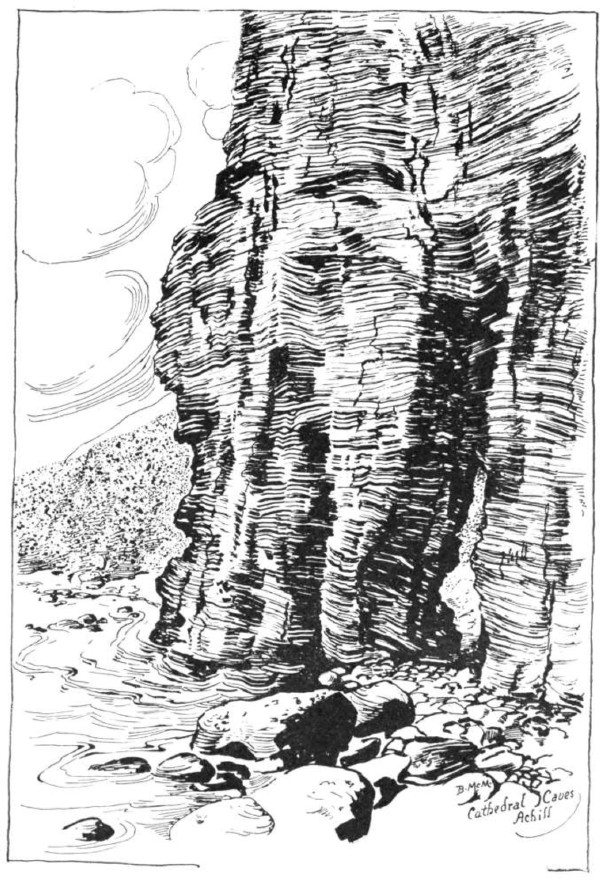 CATHEDRAL CAVES, ACHILL. Just south of Achill, in Clew Bay, is Clare Island, which has been likened to the pirate islands of the transformation scenes of the theatre. Certainly the description is a good one, as it is a spot typically suitable in shape and outline for hidden treasures, shipwrecks, and blood-letting galore. Its outline is bold and jagged, and it sits ensconced in a basin of blue water, which, in the twilight, is lit up by the western sun in a manner like nothing else so much as that of the theatre. It was perhaps merely an odd fancy — though a likely enough one — that is responsible for the simile; but it is pertinent to remark that this tiny emerald, set in a sea of sapphire, was really one of the many haunts of Grace O’Malley, the famous chieftainess and warring amazon of the sixteenth century. Here she actually did live, hoarded her arms and munitions, concealed her treasures, and imprisoned her captives, hence it is with reason that the description lives to-day. One commends the perspicacity of Grace O’Malley, or Grania Uaile, as she is sometimes called, in having selected such a beautiful spot for her stronghold, sheltered on one side by the purple hills of Connemara, and on the other guarded by the open sea. 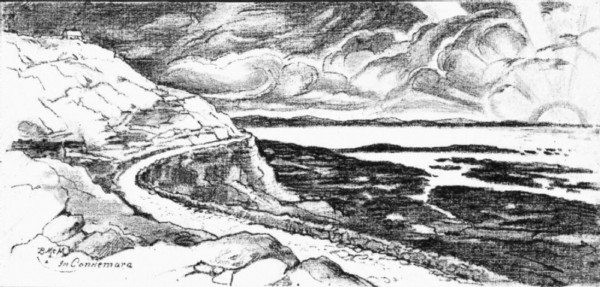 IN CONNEMARA. Next to the headlands of Kerry, Connemara is the westernmost part of Ireland. Its identity is now lost in that of County Galway, but it is still known to travellers as “wild Connemara.” Not that it is entirely unpeopled, or that there is any special hardship involved in traversing its area; the hotels are more numerous than ever, and it is an open question if the accommodation offered at Recess, Clifden, Westport, and many other of the purely tourist points is not the equal of any in Ireland. They have not the electric light in many instances, and often not water “laid on,” but the genuine traveller will not care for this if he can but be sure of his bed and board. To feel sure of the former, however, it will be necessary for him to bespeak it in advance if he travels here in the season. In Connemara there is no great wealth of historical or archæological memorials. In fact, there is a scarcity of both, and one has to take his fill of the wild, natural beauties of the rock-bound coast scenery, the bracing atmosphere, and the wholly unspoiled charm of the place, which, in spite of the advent of the great hotels before mentioned, has not yet become travel-worn. Lough Carib, which is possessed (at Oughterard) of a fine ruined castle, just north of Galway, is the largest of the score of purple, deep-looking lakes with which the western part of the county is dotted. The scenery of lake and sea, of bracken-clad hills and plains, and of great sombre, gloomy mountains makes up an ensemble of surpassing beauty. The centres of population are few, far between, and of minute dimensions. The railway line from Galway ends at Clifden, a town so unimportant and quiet that, in itself, it does not warrant remark. It was founded in the reign of George IV., and this early foundation consisted of but a single house, though it is the gateway to the wonderful coast scenery of the region to the northward, not actually in Connemara, but what is known as “Joyce’s Country.” Of all the landlocked bays of this region, none equals Killary Harbour, which is simply the elongated estuary of the tiny river Eriff. 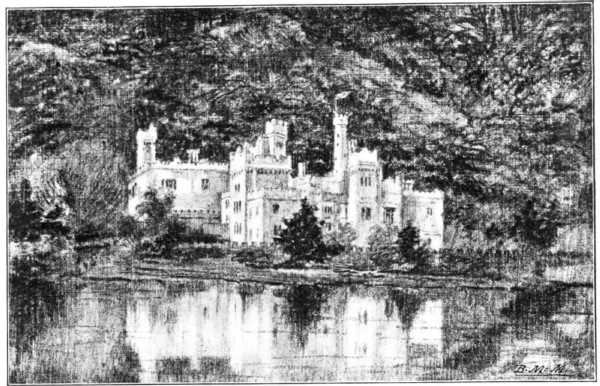 KYLEMORE CASTLE. The hamlet of Leenane is the metropolis of these parts, and is so very small and unimportant that it would hardly be remarked, except for the fact that no other of even the same rank lies within a radius of twenty miles. The situation of Leenane is charming, at the head of Great Killary. Around about are hills of mountainous pretentions, and before its doors is a fiord, as ample and as calm as many, of more fame, to be found in Norway. Seaward, the great hills come down to the water’s edge and almost join hands across the narrow mouth of the estuary, forming a sheltered and landlocked haven of so great a depth as to allow anchorage for even a great battle-ship. Between Galway and Clifden is Recess, a point of vantage from which to visit much that is characteristic of the scenery of Connemara. Firstly, the region is of interest to the fisherman; secondly, the geologist; and, thirdly, to all lovers of nature, which, judging from the recent popularity of “nature books,” is perhaps much the largest class. The chief topographical feature, which forms the background to Recess, is the mountain range of the “Twelve Bens,” a glorious group of dark-mantled mountains with stony peaks and flinty-quartz hearts. One may tramp Connemara for weeks, and not know all its beauty-spots, or he may scamper around it by coach and rail in two days, and depart thinking he has seen it all; but in either case, his memory, if it be a good one, will sooner or later call him to task for his presumption. For this reason, it is manifestly presumptuous to attempt to give its proper rank to its great wealth of natural attractions among the various collections which Ireland possesses. The scenery about Recess is a picturesque combination of lake and river and mountain; but, to the southward, there are wild and rugged bits of coast and red bracken-covered hills, which look to-day exactly as they did in times primeval. Lough Glendalough, which lies immediately before Recess, is but the foreground of a lovely picture which it will take many days to dissect and fully appreciate. There has ever been a dispute as to whether the glory of the “Twelve Bens” really belonged to Recess or Leenane. It certainly matters little, since they are a wonderfully impressive background viewed from either point. It must be a well-booted and strong-limbed pedestrian who will essay the task of ascending these famous mountains. Benbaun is the monarch of the Bens, and is 2,395 feet in height. Not a very great altitude as Continental mountains go, but withal a very respectable eminence to climb. North of Achill is Black Sod Bay, whose memory comes down to us through Kipling’s reminiscence in “A Fleet in Being.” More anciently, it was one of the harbours where a part of the ill-fated Armada was supposed to have gone ashore. There are no great centres of population here in the bleak northwest of County Mayo, and there are no architectural remains of note; but there is local colour, and much of it, for one who would study the poor Irish peasant on his native heath. Until one rounds the headland of Benwee, and passes the “Stags of Broadhaven,” — a head of deep-water pinnacles of rock whose jagged outlines have been likened to a stag’s antlers, — and reaches Killala Bay, there is naught of twentieth-century civilization to remind one he is not living in other days, or certainly in other lands and among other associations than those which city folk have come to consider necessaries.
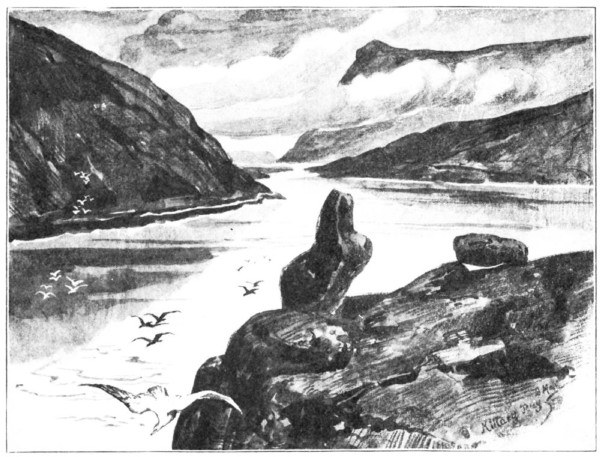 KILLARY HARBOUR. Killala Bay is flanked on the west by Downpatrick Head, which rises two thousand feet sheer above the sea-level. It is one of Ireland’s true wonders, but attracts few visitors save migratory sea-fowl. Killala itself, one learns from the “Life of St. Patrick,” is a place of great age. The holy man himself —
“Came to a pleasant place where the river Muadas (Moy) empties itself into the ocean; and on the south banks of said river he built a noble church called Kill Aladh, of which he made one of his disciples, Muredach, the first bishop.”
The present cathedral was entirely rebuilt in the seventeenth century, and has no architectural importance. Close by, on a knoll, about which the village is built, is a round tower, eighty-four feet high and fifty-one feet in circumference.
“At Kilcummin, on the west side of Killala Bay, a body of French troops, under General Humbert, landed, August 22, 1798, with the object of supporting the United Irishmen. They at once took Killala and Ballina, and at Castlebar the government levies were in such haste to retire without fighting as to give rise to the nickname, ‘Castlebar Races.’”
Ballina, at the head of Killala Bay, is the “tourist resort” of the region. It is pleasant and delightful in all of its aspects, and in its neighbourhood are some very interesting architectural remains. There are, as is often the case, a Roman Catholic and a Protestant cathedral in the town, and an Augustinian monastery, a ruin of a fifteenth-century structure, also many attractive vistas and spots most worthy of the brush and pencil of the artist. These attractions pall in the mind of the local spreader of publicity, who extols only the size and varieties of fish which may be taken in the river Moy and other near-by waters. From Ballina one reaches Sligo in five and a half hours by means of that still prevalent institution, the genuine Irish “low-backed car.” Somewhere in the county of Sligo is the “Valley of the Black Pig,” which is possessed of a legend which recounts how, for generations, the Irish peasantry have comforted themselves in adversity by the memory of a great battle fought here in this valley. W. B. Yeats tells how, a few years ago, in the barony of Lisadell in Sligo, a peasant would fall to the ground in a trance as it were, and rave out a description of the bloody battle which once took place. This shows, at least, that tradition and legend alike die hard in the minds of the people, and when Mr. Yeats tells us that men have told him that they have seen the girths instantaneously rot and fall from horses; and that few, if any, who enter the Black Valley ever come out alive, we realize fully how close we are, even in these times, to the age of superstition in Ireland. Mr. Yeats furthermore eulogized the incident in verse.
“The dew drops slowly; the dreams
gather; unknown spears
Suddenly hurtle before my dream-awakened eyes; And then the clash of fallen horsemen, and the cries Of unknown perishing armies beat about my ears. We, who are labouring by the cromlech on the shore, The gray cairn on the hill, when day sinks drowned in dew, Being weary of the world’s empires, bow down to you, Master of the still stars, and of the
flaming door.”
Sligo itself, with its ten thousand souls and its important and matter-of-fact seafaring trades, is a centre for journeying afoot or awheel amid many charming scenes of lough and lake and sea and shore. Southward is Carrick on Shannon, the gateway to the Shannon’s lakes and rivers; northward is the Bay of Donegal, backed by its famous rugged “Highlands;” and, eastward, is Lough Erne, which, with its upper and lower lakes and the river Erne trickling minutely southward, is quite the rival of the long-drawn-out Shannon, or would be if the tide of popular fancy ever turned that way. Enniskillen is the metropolis of Lough Erne. Locally it is known as the Island City by reason of its being apparently surrounded by the all-enfolding waters of the upper and lower lakes. Its fame lies principally in its entrancing situation, and the memory of its various regiments of Enniskillen Dragoons who have fought and won gloriously in many of England’s “little wars,” and big ones, too, for that matter. The colours borne by the two Enniskillen regiments at Waterloo are still preserved in the parish church. Until the days of James I., Enniskillen was no more than a stronghold of the Maguires, but it then gained much prominence through the eventful part it played in the domestic struggles and troubles of the latter half of the seventeenth century. Of the old castle, which has braved so many fights, only a small portion remains, and is incorporated in the modern military barracks, which, in one way, indicate the importance of Enniskillen. “The Falls of Erne,” at Ballyshannon, where the river joins its estuary with its rapid, tumbling torrent falling over a thirty-foot wall of rock, indicate in no unmistakable manner the volume of water which flows from source to sea. At Ballyshannon, which has more than a local renown among disciples of Izaak Walton, is the famous “salmon leap” which, at certain seasons, provides a display of the wonderful acrobatic ability of this gamy fish. But a short three miles from Ballyshannon is Belleek, with its famous china factories which produce a peculiarly lustrous egg-shell ware much admired for its simplicity and crudeness of form, but very transparent and light. Here, too, are another series of rapids, as great in their way as those farther down-stream. Sir Joseph Paxton called them “the most picturesque in the world,” but one should judge for himself. They are marvellously effective, however, for the river falls nearly 150 feet in three miles or less. Sligo itself, in spite of its commercial importance, is not greatly appealing in its interest, if one excepts its old abbey, now a ruin, but once an exceedingly ambitious Dominican establishment. Founded in 1252, it was destroyed by a fire in 1414, though immediately rebuilt. Its Gothic is of that superlative quality known best in the superb monkish erections of the Continent of Europe. There are various monuments yet to be seen therein of local and historical interest, but the chief attraction is what remains of the beautiful cloister, fairly perfect as to preservation, and surrounding three sides of a rectangle. There are forty-six arches, each about four feet and a half in height, all elaborately carved, and quite different one from another. By an ancient and inalienable right, the abbey grounds are still used as a Roman Catholic burial-place.
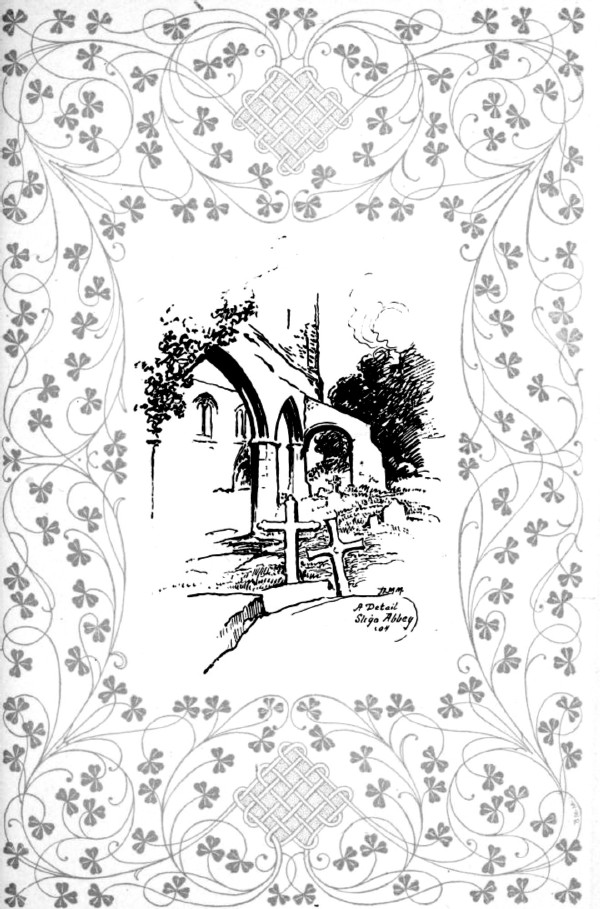 A Detail of Sligo Abbey |